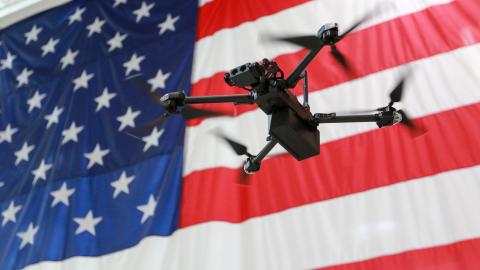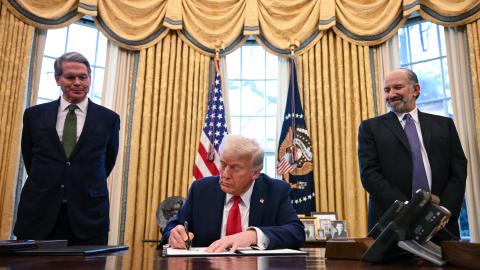It took only a tiny drop of 0.1% in fourth-quarter GDP to produce another battle in the ideological war that is going on in Washington. Republicans blame it on the president's spending and deficits, the president and his team on the congressional Republicans they call a "major headwind," and on Fox News for opposing Barack Obama's plans for more spending and higher taxes.
The president says there is no spending problem, Republicans that spending is the problem.
Which brings us to what is known as the sequester. It is the last weapon left to Republican spending-cutters who bottled out in the fiscal cliff fight by allowing taxes and tax rates to rise, and have allowed the debt ceiling to rise for the next few months without obtaining significant spending cuts as a quid pro quo. Unless a deal is reached to cut the deficit by $1.2 trillion over the next 10 years, spending cuts will be triggered, to fall equally on defence and on some domestic programmes.
The theory was that these cuts would be repugnant to Republicans--who fear that $600bn of defence cuts would "devastate" the military, to use the word of Leon Panetta, Obama's departing defence secretary--and unappealing to Democrats because their favoured social programmes would share the pain with the military. This mutual distaste would force the parties to agree to replace the sequester meat axe with a scalpel.
No such luck. The president insists that any deal include more tax increases on the "wealthy," while the Republicans are adamant that the $600bn increase he wrung from them during the fiscal cliff negotiations is all the new taxes he will ever get. Add that Republicans believe incoming defence secretary Chuck Hagel has been told to cut back on the military. Since they can't save the defence budget, Republicans figure they might as well use the sequester to get the cuts in domestic programmes the president has said he would not countenance if he had the power to block them. Which is why it is now considered likely the sequester will be allowed to take effect on March 1.
Its effects are already being felt. The Pentagon, benefiting from the troop drawdowns in Iraq and Afghanistan, and knowing the bean counters are sharpening their pencils, cut spending in the last quarter by 22%, the largest such cut in 50 years. Along with a decline in inventories, that reduction accounted for most of the 0.1% fourth-quarter GDP decline. Pentagon suppliers began cutting staff last year, most visibly in the headquarters and research facilities surrounding the capital, their wailings and those of their workers and lobbyists clearly audible in the halls of Congress. As is their prediction that the sequester would add 2m to the 12m already unemployed and produce a second consecutive quarter of negative growth, the standard definition of "recession."
Meanwhile, with 75% of the 200 companies that have so far reported earnings beating analysts' forecasts, and the Fed keeping interest rates close to zero, investors drove share prices up a rousing 5% last month. They were undeterred by the decline of 0.1% in the fourth quarter because that aggregate figure obscured the healthy growth of the core drivers of the economy.
Businesses stepped up spending on plant, equipment and software at an annual rate of 8.4%. Consumers, who continue to trade-in old vehicles, many with 150,000-200,000 miles on the clock, for sleeker, electronics-laden, fuel-efficient ones, upped spending at a 2.2% rate. Add the 15.3% growth in residential investment as the housing sector continues its recovery: home builders are rushing to meet the demand that is reflected in shortages of homes for sale and rising prices (up 5.5% in the past year), and which spurs sales of everything from furniture and carpets to power tools. All in all, the growth drivers added 2.7% to fourth quarter 2012 growth.
Throw in three other factors that minimise the importance of the 0.1% fourth-quarter decline. The reduction in government spending in late 2012 is not altogether a bad thing: if sustained, it might bring down the deficit. Second, the drop in inventories means more stuff moved off the shelves than was added to stocks, setting the stage for re-stocking in the next quarter. Finally, the Federal Reserve Board's monetary policy committee notes that "weather-related disruptions and other transitory factors" added to the downward tug in the fourth quarter. So there is little reason to treat the 0.1% fourth-quarter downtick as a harbinger of hard times to come, and more reason to give weight to the growth in the consumer, business and housing sectors, not to mention the favourable demographic, energy and insourcing trends referred to in last week's column.
Still, it would be prudent to keep the champagne on ice, unopened.
* The 157,000 jobs created last month were too few to prevent a modest uptick in the unemployment rate from 7.8% to 7.9%, or to provide work for the more than 12m unemployed workers.
* The 2.6% gain in personal income in December was inflated by bringing forward into 2012 dividends originally scheduled to be paid in 2013, in order to beat the dividend-tax increase.
* Sequester spending cuts might knock some 0.7% off GDP growth this year.
Then there are things we don't yet know.
* The impact of the January 1 increase in payroll taxes: the average family has been hit with a $20-per-week cut in take-home pay.
* Whether the wealthy, faced with increases in tax rates on their incomes and capital gains, an Obamacare tax on investment income and whatever other bad news the Obama administration has in store for them, will rein in spending.
* Whether small businesses faced with substantial Obamacare penalties if they have more than 50 workers will continue to hold off on hiring and investment.
Add to these known unknowns the unknown unknowns, political and economic, and it would be foolish to claim a clear crystal ball. Still, this economist can't help feeling that the US economy will grow at a faster rate than the 1.5% consensus forecast.

















